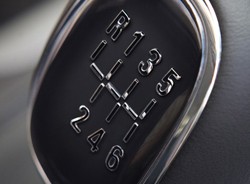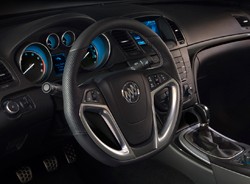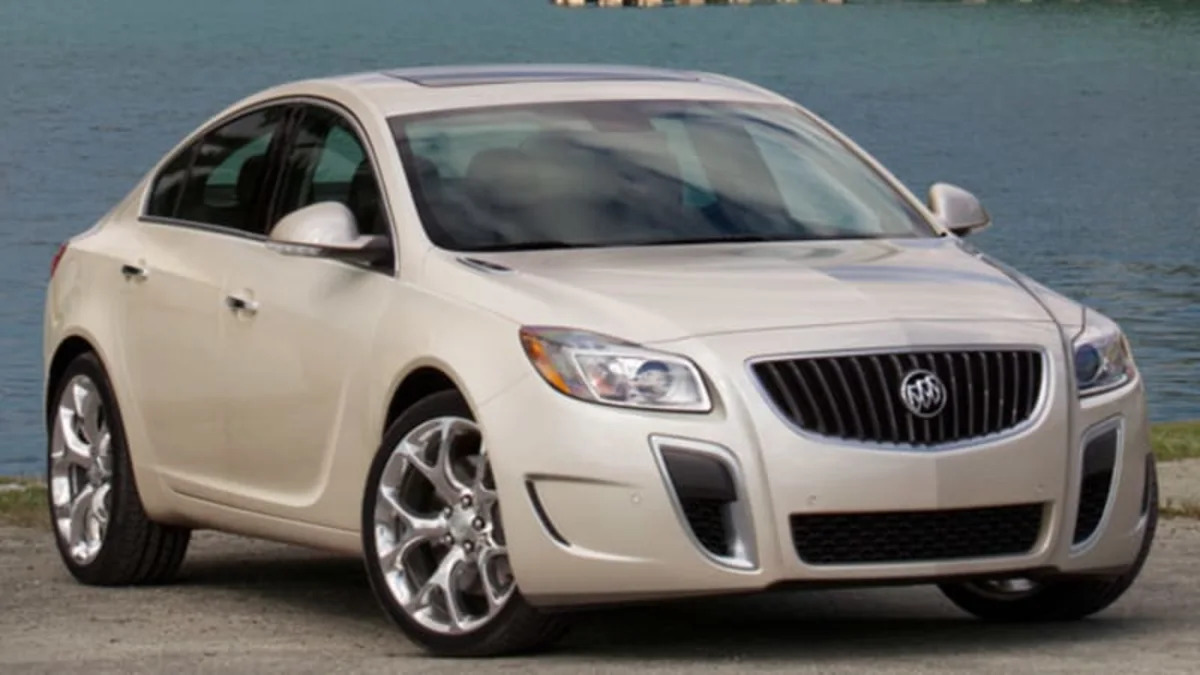General Motors left us on the edge of our seats at this year's Detroit Auto Show when its Buick Regal GS show car was unveiled. A few months later, GM confirmed that the sportier Regal was headed for production, and now, just a short time before the sedan's official debut at the Los Angeles Auto Show, we have official information and photos of the production-ready car. Ladies and gentlemen, the 2012 Buick Regal GS has arrived.
GM has, of late, made great strides to rework Buick's image here in the United States, trying to inject some youth and enthusiasm in a brand that has long been associated with a much older crowd of buyers. This top-rung Regal is based heavily on the performance-oriented Opel Insignia OPC, one of Europe's most praised sport sedans, and while the U.S.-spec car you see here certainly looks like it's fresh off the boat, it has been toned-down in its transoceanic journey. We get the Opel's beefed-up visuals with large, fang-like air intakes up front, big exhaust-work out back and optional 20-inch satin chrome wheels (19s are standard, if that's more your style), but where the Regal GS begins to separate itself from the Insignia OPC isn't visible from outside.
 Powering the GS is The General's turbocharged 2.0-liter Ecotec inline-four, estimated to produce 255 horsepower at 5,300 rpm and 295 pound-feet of torque from 2,500 to 4,000 rpm. To any enthusiast's delight, this power runs solely through a six-speed manual transmission, though we're told that a six-speed automatic with paddle shifters will be available shortly after launch. The Opel OPC, for the record, receives a force-fed 2.8-liter V6 that generates 325 horsepower and 295 pound-feet of torque.
Powering the GS is The General's turbocharged 2.0-liter Ecotec inline-four, estimated to produce 255 horsepower at 5,300 rpm and 295 pound-feet of torque from 2,500 to 4,000 rpm. To any enthusiast's delight, this power runs solely through a six-speed manual transmission, though we're told that a six-speed automatic with paddle shifters will be available shortly after launch. The Opel OPC, for the record, receives a force-fed 2.8-liter V6 that generates 325 horsepower and 295 pound-feet of torque.
Unlike the show car that GM rolled out back in January (and unlike the Buick's European counterpart), all-wheel drive will not be available on U.S.-spec models. Front-wheel drive doesn't sound too elegant for a sport sedan like this, but GM has fitted its High Performance Strut (HiPerStrut) front suspension design which we've found to curb torque steer and reduce understeer in other applications. We asked GM why it decided to omit AWD, and the simple answer is this: It's cheaper to use front-wheel drive and the automaker is completely confident that its HiPerStrut system will fare just as well. We've tested this system in the larger LaCrosse and a variation of it on the Saab 9-5, and although we'll wait until we get some street (or track) time before we reach a final consensus, we don't think the GS will be all that unruly when pushed hard, especially given the lowered power output.
Uprated Brembo brakes promise to keep the power in check, and GM's new Interactive Drive Control with standard, sport and high-engagement GS mode allows the driver to tweak the suspension and steering feel.
 Inside the GS, the Regal's cockpit has largely been left alone, save the addition of some sport enhancements. A flat-bottom sport steering wheel is standard, as are heated, leather sport seats. Other standard goodies include things like Bluetooth, XM satellite radio, park assist and bi-Xenon headlamps.
Inside the GS, the Regal's cockpit has largely been left alone, save the addition of some sport enhancements. A flat-bottom sport steering wheel is standard, as are heated, leather sport seats. Other standard goodies include things like Bluetooth, XM satellite radio, park assist and bi-Xenon headlamps.
We're definitely ready to see how the Regal GS fares out on the road, and we'll get our first taste closer to the car's on-sale date, currently scheduled for the third or fourth quarter of 2011. Follow the jump for GM's official press release with all of the details.
[Source: General Motors]
• High-performance midsize sport sedan with 0-60 mph performance of under seven seconds
• Features exclusive, GS-only high-output version of the Ecotec 2.0L turbo engine with 255 hp and 295 lb.-ft. of torque
• Buick's Interactive Drive Control System allows drivers to change the suspension settings and steering sensitivity
• Exclusive, racing-inspired exterior and interior appointments
• Goes on sale in the second half of 2011
MIAMI – Buick this evening reveals the production version of the 2012 Regal GS, an even sportier expression of the Regal sport sedan that went on sale earlier this year and has attracted new buyers to the Buick family. Powered by a high-output, exclusive Ecotec 2.0L turbocharged engine mated to a six-speed manual transmission, the GS delivers an estimated 255 horsepower (190 kW) and 295 lb.-ft. of torque for a 0-60 mph performance of less than seven seconds (estimated). Buick's Interactive Drive Control System is standard on the GS, allowing drivers to customize the driving experience by changing the suspension settings and steering sensitivity between three modes: standard, sport and GS.
"Built on the performance foundation of the Regal, the Regal GS was designed as an even sportier expression of responsive performance and style," said John Schwegman, vice president of Buick marketing. "The driving experience is powerful and spirited; and the GS represents the next entry in Buick's product renaissance."
The Regal GS will be unveiled this evening at a consumer event in Miami. It goes on sale in the second half of 2011. Pricing has not yet been announced.
Product highlights include:
• Exclusive Ecotec 2.0L turbocharged and intercooled engine rated at an estimated 255 horsepower (190 kW) and 295 lb-ft of torque (400 Nm)
• Six-speed manual transmission, with six-speed automatic with Driver Shift Control to be offered later
• Interactive Drive Control System with GS mode
• Four-wheel independent system with HiPerStrut front suspension
• High-performance four-wheel disc brake system with Brembo front calipers
• Standard 19-inch, 5-Twin Spoke alloy wheels and all-season tire and optional 20-inch, 5-Twin Spoke polished alloy wheels with performance tires.
The exterior design features unique front and rear fascias, with the front fascia incorporating prominent, vertical air intake slots and specific grille treatment – with the vertical elements accented in a satin-metallic finish. The rear fascia has a pair of integrated, satin-metallic trapezoidal exhaust outlets. Rocker panel extensions and an integrated rear spoiler are also woven into the design. The GS cuts a sportier stance, too, with a slightly lower ride height than other models and aggressive 19-inch, 5-Twin Spoke alloy wheels and all-season tires (20-inch, 5-Twin Spoke polished alloy wheels with performance tires are optional).
Inside is a racing-inspired, flat-bottom sport steering wheel and metal sport pedals, along with leather-appointed 12-way power-adjustable sport driver and front passenger heated seats, which include four-way power lumbar. The GS-specific black interior is accented with satin-finish elements on the instrument panel, steering wheel and console, while the instrument panel glows white when the driver engages the GS mode of the Interactive Drive Control System (IDCS).
Standard amenities for the Regal GS include:
• Passive keyless entry with push-button start
• Standard XM Satellite Radio with three-month trial service
• Harmon/Kardon premium 320-watt sound system with nine speakers
• Bluetooth phone connectivity
• Leather-wrapped flat-bottom steering wheel with audio controls
• Leather-appointed sport seating
• Heated driver and front passenger seats, with 12-way adjustable driver and front passenger seats – including four-way lumbar adjustment
• 120-volt accessory power outlet
• Power windows with express up/down feature in the front and express down in the rear.
• Front and rear ultrasonic parking assist
• Bi-xenon HID headlamps.
Turbocharging and HiPerStrut
Power for the Regal GS comes from a high-output version of the Ecotec 2.0L turbocharged DOHC VVT engine with direct injection technology. It is based on the engine that will be available on Regal CXL later this year, but the engine and turbocharger are tuned to deliver greater boost pressure in the GS. The output is rated at 255 horsepower (190 kW) and 295 lb.-ft. of torque (400 Nm). A three-inch-diameter exhaust system provides reduced back pressure, resulting in higher engine power
Direct injection technology helps the engine deliver more power through increased efficiency, while maintaining fuel economy and lowering emissions. That means less fuel is consumed and lower emissions generated – including a 25-percent drop in cold-start hydrocarbon emissions. Variable valve timing optimizes power, efficiency and emissions across the entire rpm band.
"We've been combining direct injection and variable valve timing with boosted engines since 2006, and there's no question the Regal GS turbo has the responsiveness and acceleration of a 3.5L V6, while delivering the fuel economy of a 2.0L four," said Mike Anderson, Ecotec global chief engineer and program manager.
The engine is mated to a standard six-speed manual transmission. A six-speed automatic transmission will be available later.
The Regal GS rides on a relatively long wheelbase of 107.8 inches (2738 mm), which delivers refined, well-balanced vehicle dynamics. It also features a four-wheel-independent suspension, with a unique High Performance Strut (HiPerStrut) front suspension design. The HiPerStrut system helps reduce torque steer and maintain negative camber during cornering; the driver experiences reduced torque steer, improved grip and increased cornering power, along with crisper handling, steering precision and feedback.
The four-link independent rear suspension is designed to minimize unwanted toe and camber effects during spirited driving maneuvers, enhancing vehicle stability. Both front and rear dampers incorporate active Computer Damping Control (CDC), continuously changing damper characteristics to maintain optimal vehicle ride control over varying road surfaces and profiles. More aggressive, performance-oriented damping characteristics can also be selected by the driver through the Interactive Driver Control System.
Braking power comes from a large diameter four-wheel disc brake system featuring Brembo front calipers. A standard, four-channel anti-lock brake system is tuned to reduce stopping distances over varied road surfaces and conditions. An electronic parking brake is actuated via a center console-mounted control. The Regal GS also features standard StabiliTrak stability control system with integrated, full-function traction control.
Interactive Drive Control System
The Regal GS is also equipped with Interactive Drive Control System (IDCS) chassis technology (also offered on other Regal models with the 2.0L turbo engine). It delivers enhanced vehicle stability and greater driving safety. The driver selects among three operating modes – standard, sport and GS – that change the suspension settings, and steering sensitivity through the variable-effort steering system.
A sophisticated driving mode control module continually monitors driving style utilizing yaw rate, lateral and longitudinal acceleration, steering wheel, throttle and vehicle speed. It defines the dynamic vehicle state, including acceleration, braking and cornering, to optimize chassis reactions. It also executes all of the IDCS driver selections. All four dampers are electronically controlled and continuously adapt within milliseconds to the prevailing road conditions, vehicle movements and individual driving style.
Selecting GS mode optimizes the car for dynamic driving, tightening the suspension and steering response. "Standard," or the default mode, is the setting for all-around use. The sport mode provides a level of performance between standard and the GS modes.
BUICK REGAL GS SPECIFICATIONS
Overview
| Models: |
2012 Buick Regal GS |
| Body style / driveline: |
four-door, five-passenger, front-engine transaxle. Front-wheel drive midsize sedan |
| Construction: |
steel body frame integral (unibody) with front and rear crumple zones; galvanized steel front fenders, hood, roof, door panels, one-piece bodyside outer panel, thermal plastic olefin (TPO) bumper fascias |
| EPA vehicle class: |
midsize |
| Manufacturing location: |
Ontario, Canada (Oshawa) |
| Key competitors: |
Acura TSX, Audi A4 |
Engines
|
|
2.0L DOHC VVT I-4 ECOTEC Turbo High Output |
| Displacement (cu in / cc): |
122 / 1998 |
| Bore and stroke (in / mm): |
3.39 x 3.39 / 86 x 86 |
| Block material: |
cast aluminum |
| Cylinder head material: |
cast aluminum |
| Valvetrain: |
overhead camshafts, four-valves per cylinder, continuous variable valve timing for intake and exhaust |
| Ignition system: |
individual coil-on-plug |
| Fuel delivery: |
direct injection with variable high-pressure rail and electronic throttle control |
| Compression ratio: |
9.2:1 |
| Horsepower (hp / kW @ rpm): |
255 / 190 @ 5300 (est.) |
| Torque (lb-ft / Nm @ rpm) |
295 / 400 @ 2500-4000 (est.) |
| Recommended fuel: |
premium recommended but not required |
| Max engine speed: |
6350 rpm |
| Emissions controls: |
close-coupled catalytic converter; variable valve timing; 58x ignition system; returnless fuel rail; wide-range O2 sensor |
| Estimated fuel economy |
19 / 29 (manual) 18 / 28 (automatic) |
Transmission
|
|
2.0L DOHC VVT I-4 ECOTEC Turbo High Output |
| Displacement (cu in / cc): |
122 / 1998 |
| Bore and stroke (in / mm): |
3.39 x 3.39 / 86 x 86 |
| Block material: |
cast aluminum |
| Cylinder head material: |
cast aluminum |
| Valvetrain: |
overhead camshafts, four-valves per cylinder, continuous variable valve timing for intake and exhaust |
| Ignition system: |
individual coil-on-plug |
| Fuel delivery: |
direct injection with variable high-pressure rail and electronic throttle control |
| Compression ratio: |
9.2:1 |
| Horsepower (hp / kW @ rpm): |
255 / 190 @ 5300 (est.) |
| Torque (lb-ft / Nm @ rpm) |
295 / 400 @ 2500-4000 (est.) |
| Recommended fuel: |
premium recommended but not required |
| Max engine speed: |
6350 rpm |
| Emissions controls: |
close-coupled catalytic converter; variable valve timing; 58x ignition system; returnless fuel rail; wide-range O2 sensor |
| Estimated fuel economy |
19 / 29 (manual) 18 / 28 (automatic) |
Chassis/Suspension
| Front: |
independent, MacPherson strut-type with dual-path mountings, specifically tuned coil springs, direct-acting stabilizer bar (hollow); hydraulic ride bushings; continuous damping control (Interactive Drive Control System) |
| Rear: |
four-link independent rear; hollow stabilizer bar; continuous damping control (IDCS) |
| Traction control: |
all-speed using engine torque reduction and brake intervention |
| Steering type: |
hydraulic, variable-effort |
| Steering wheel turns lock-to-lock: |
2.68 |
| Turning circle, curb-to-curb (feet / meters): |
37.4 / 11.4 (19-inch wheels) |
| Steering ratio: |
15.2:1 |
Brakes
| Type: |
four-wheel disc w/ABS (w/ESC) |
| Brake rotor diameter – front (in / mm): |
14.0 / 355 vented; four-piston aluminum Brembo caliper |
| Brake rotor diameter – rear (in / mm): |
12.4 / 315 vented; single-piston, aluminum caliper |
Wheels/Tires
| Wheel size and type: |
19-inch alloy, 5-Twin Spoke 20-inch polished alloy, 5-Twin Spoke |
| Tires: |
Goodyear Eagle RSA P245/40R19 Pirelli P-Zero P255/35-ZR20 |
Dimensions
Exterior
| Wheelbase (in / mm) : |
107.8 / 2738 |
| Overall length (in / mm): |
190.2 / 4831 |
| Overall width (in / mm): |
73.1 / 1811 |
| Overall height (in / mm): |
58 / 1480 |
| Front track (in / mm): |
62.4 / 1585 |
| Rear track (in / mm): |
62.5 / 1587 |
Interior
| Seating capacity (front / rear): |
2 / 3 |
| Headroom (in / mm): |
38.8 / 985 (front) |
| Legroom (in / mm): |
42.1 / 1069 (front) |
| Shoulder room (in / mm): |
56.7 / 1440 (front) |
| Hip room (in / mm): |
55.4 / 1407 (front) |
| EPA passenger volume (cu ft / L) : |
96.81 / 2741 |
| EPA interior volume (cu ft / L): |
111.1 / 3146 |
| Cargo volume (cu ft / L): |
14.25 / 403 |
Capacities
| Fuel tank (gal / L): |
18.5 / 70 |
| Engine oil (qt / L): |
6.3 / 6.0 |
| Curb weight (lb / kg): |
3710 /1683 |



Sign in to post
Please sign in to leave a comment.
Continue